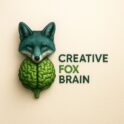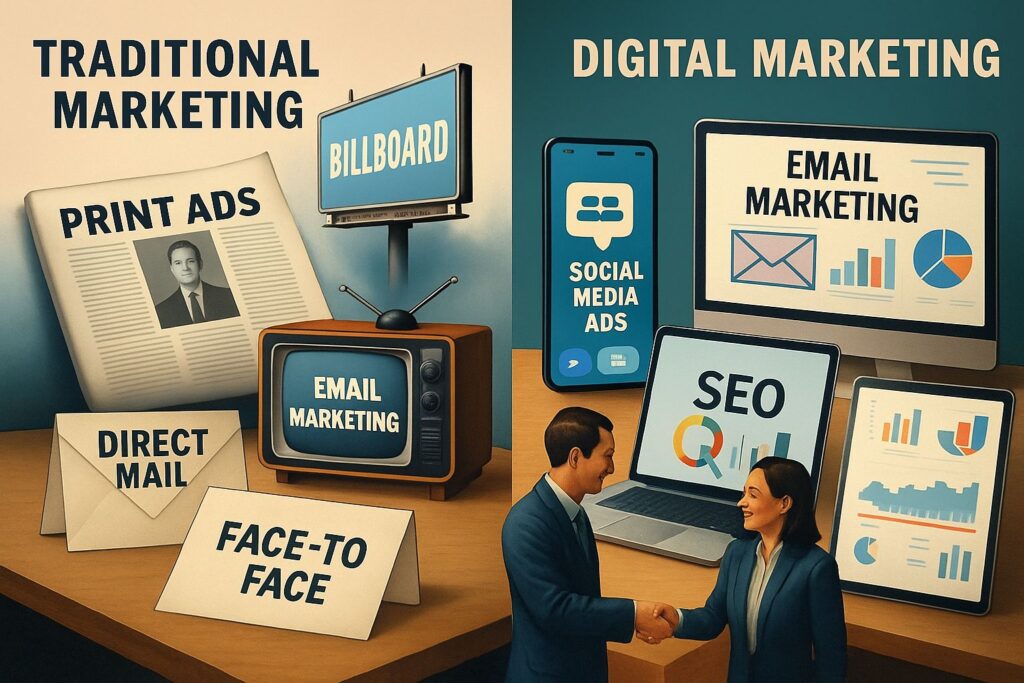Marketing has undergone a radical transformation over the past few decades. What was once dominated by print ads, TV commercials, and cold calls has now evolved into a data-driven, multi-channel ecosystem. In 2025, the competition is fiercer than ever, and businesses must adopt modern strategies to stay relevant and profitable.
This blog provides a detailed comparison of old-school marketing tactics versus today’s digital marketing strategies, focusing on why modern methods deliver more precise, measurable, and cost-effective results.
Old Marketing Methods: Traditional But Limited
- Print Advertising
• Newspapers, magazines, flyers, brochures.
• Pros: Tangible, trusted by older demographics.
• Cons: High cost, no performance tracking, limited reach and engagement.
- TV and Radio Commercials
• Broadcast to mass audiences during specific time slots.
• Pros: High brand visibility and impact.
• Cons: Extremely expensive, hard to measure ROI, unable to target specific audiences.
- Cold Calling & Direct Mail
• Manual outreach via phone calls or mailed letters.
• Pros: Personal touch, direct communication.
• Cons: Time-consuming, low response rate, viewed as intrusive.
- Billboards and Physical Advertisements
• Placed in high-traffic locations.
• Pros: Good for local brand awareness.
• Cons: No interaction, impossible to track effectiveness precisely.
Why These Old Methods Are Becoming Obsolete
• Lack of Targeting: Advertisements were broadcasted to everyone without segmentation, wasting budget on uninterested audiences.
• No Real-Time Feedback: Marketers couldn’t adjust campaigns based on data, making optimization impossible.
• High Costs, Low Efficiency: Traditional marketing often required large budgets for limited or unpredictable results.
Key Advantages of Modern Strategies
A. Precise Targeting
Unlike traditional methods that broadcast messages to broad audiences, digital strategies allow precise targeting based on:
• User demographics (age, location, job role)
• Behavior (visited pages, previous purchases)
• Interests (industry-specific topics)
B. Measurable Performance
Modern marketing relies heavily on data:
• Google Analytics tracks user flow and conversions
• Ad Platforms provide detailed CTR, CPC, and ROAS metrics
• A/B Testing helps optimize campaigns over time
C. Cost Efficiency
• Pay only for actual clicks or leads
• Lower cost per acquisition compared to mass broadcast methods
• Organic strategies (like SEO) build long-term assets without recurring costs.
Modern Digital Marketing Strategies: Data-Driven and Agile
- Search Engine Optimization (SEO)
• Drives organic traffic via Google by optimizing website structure, content, and technical factors.
• Benefit: Long-term, compounding visibility; precise keyword targeting based on user intent. - Pay-Per-Click (PPC) Advertising
• Platforms like Google Ads, Facebook Ads, LinkedIn Ads.
• Benefit: Highly targeted campaigns, real-time budget control, performance-driven (CPC, CPA). - Social Media Marketing
• Platforms: Instagram, LinkedIn, TikTok, Twitter.
• Benefit: Precise audience segmentation, interactive content, real-time performance measurement. - Content Marketing
• In-depth articles, videos, infographics.
• Benefit: Positions the brand as an authority, helps SEO, and nurtures prospects through value-driven content. - Email Marketing Automation
• Targeted email sequences based on user behavior.
• Benefit: Personalized messaging at scale, high ROI, measurable engagement.


